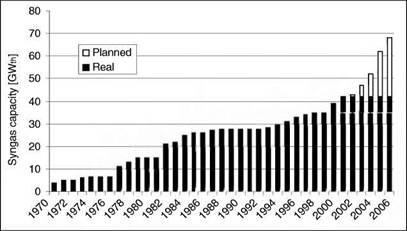 GASIFICATION TODAY
GASIFICATION TODAY
The last ten years have seen the start of a renaissance of gasification technology, as can be seen from Figure 1-1. Electricity generation has emerged as a large new market for these developments, since gasification is seen as a means of enhancing the
|
Figure 1-1. Cumulative Worldwide Gasification Capacity (Source: Simbeckand Johnson 2001) |
environmental acceptability of coal as well as of increasing the overall efficiency of the conversion of the chemical energy in the coal into electricity. The idea of using synthesis gas as a fuel for gas turbines is not new. Gumz (1950) proposed this already at a time when anticipated gas turbine inlet temperatures were about 700°C. And it has largely been the development of gas turbine technology with inlet temperatures now of 1400°C that has brought this application into the realm of reality. Demonstration plants have been built in the United States (Cool Water, 100 MW, 1977; and Plaquemine, 165MW, 1987) and in Europe (Liinen, 170MW, 1972; Buggenum, 250 MW, 1992; and Puertollano, 335 MW, 1997).
A second development, which has appeared during the 1990s, is an upsurge in gasification of heavy oil residues in refineries. Oil refineries are under both an economic pressure to move their product slate towards lighter products, and a legislative pressure to reduce sulfur emissions both in the production process as well as in the products themselves. Much of the residue had been used as a heavy fuel oil, either in the refinery itself, or in power stations as marine bunker fuel. Residue gasification has now become one of the essential tools in addressing these issues. Although heavy residues have a low hydrogen content, they can be converted into hydrogen by gasification. The hydrogen is used to hydrocrack other heavy fractions in order to produce lighter products such as gasoline, kerosene, and automotive diesel. At the same time, sulfur is removed in the refinery, thus reducing the sulfur present in the final products (Higman 1993). In Italy, a country particularly dependent on oil for power generation, three refineries have introduced gasification technology as a means of desulfurizing heavy fuel oil and producing electric power. Hydrogen production is incorporated into the overall scheme. A similar project was realized in Shell’s Pernis refinery in the Netherlands. Other European refineries have similar projects in the planning phase.
An additional driving force for the increase in partial oxidation is the development of “Gas-to-liquids” projects. For transport, liquid fuels have an undoubted advantage. They are easy to handle and have a high energy density. For the consumer, this translates into a car that can travel nearly 1000 km on 50 liters of fuel, a range performance as yet unmatched by any of the proposed alternatives. For the energy company the prospect of creating synthetic liquid fuels provides a means of bringing remote or “stranded” natural gas to the marketplace using existing infrastructure. Gasification has an important role to play in this scenario. The Shell Middle Distillate Synthesis (SMDS) plant in Bintulu, Malaysia, producing some 12,000 bbl/d of liquid hydrocarbons, is only the first of a number of projects currently in various stages of planning and engineering around the world (van der Burgt 1988).
REFERENCES
Brooks, С. T., Stroud, H. J. F., and Tart, K. R. “British Gas/Lurgi Slagging Gasifier.” In Handbook ofSynfuels Technology, ed. R. A. Meyers. New York: McGraw-Hill, 1984. Dittus, M., and Johnson, D. “The Hidden Value of Lignite Coal.” Paper presented at Gasification Technologies Conference, San Francisco, October 2001.
Gumz, W. Gas Producers and Blast Furnaces. New York: John Wiley & Sons, 1950. Higman, C. A. A. “Partial Oxidation in the Refinery Hydrogen Management Scheme.” Paper presented at AIChE Spring Meeting, Houston, March 1993.
Schlinger, W. G. “The Texaco Coal Gasification Process.” In Handbook ofSynfuels Technology, ed. R. A. Meyers. New York: McGraw-Hill, 1984.
Simbeck, D., and Johnson, H. “World Gasification Survey: Industry Trends and Developments.” Paper presented at Gasification Technologies Conference, San Francisco, October 2001. Slack, A. V., and James, G. R. Ammonia, Part /New York: Marcel Dekker, 1973.
Speich, P. “Braunkohle—auf dem Weg zur groBtechnischen Veredelung.” VIK-Mitteilungen 3/4(1981).
van der Burgt, M. J. “Shell’s Middle Distillate Synthesis Process.” Paper presented at AIChE Meeting, New Orleans, 1988.
van der Burgt, M. J. “Technical and Economic Aspects of Shell-Koppers Coal Gasification Process.” Paper presented at AIChE Meeting, Anaheim, CA 1978.
Chapter 2
